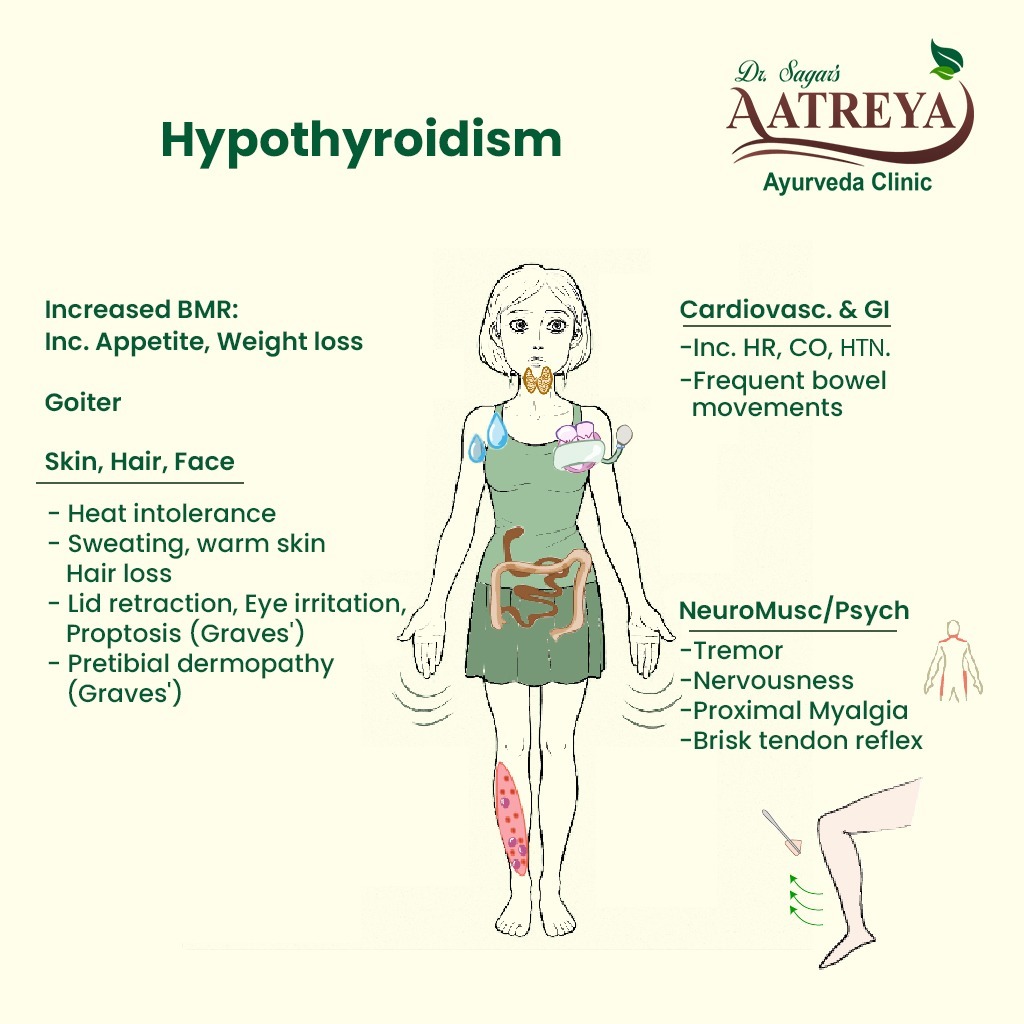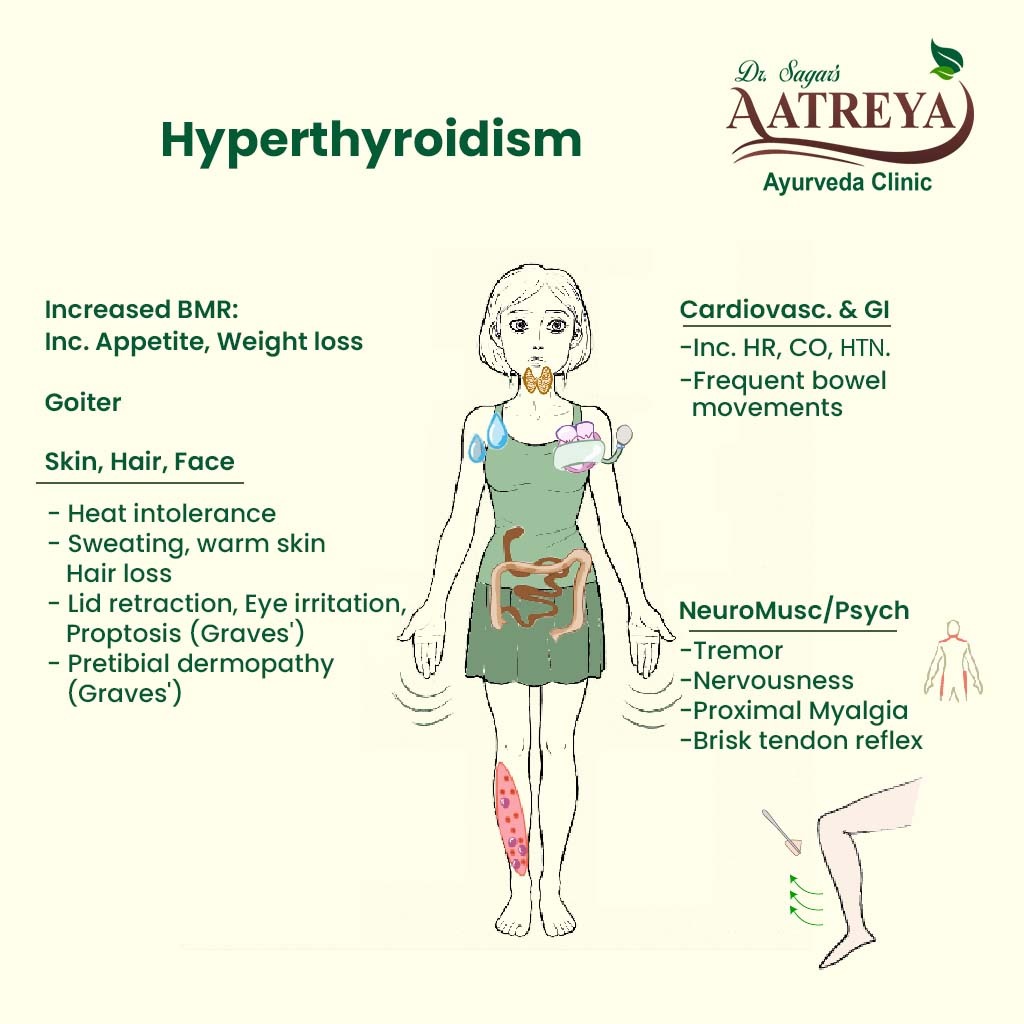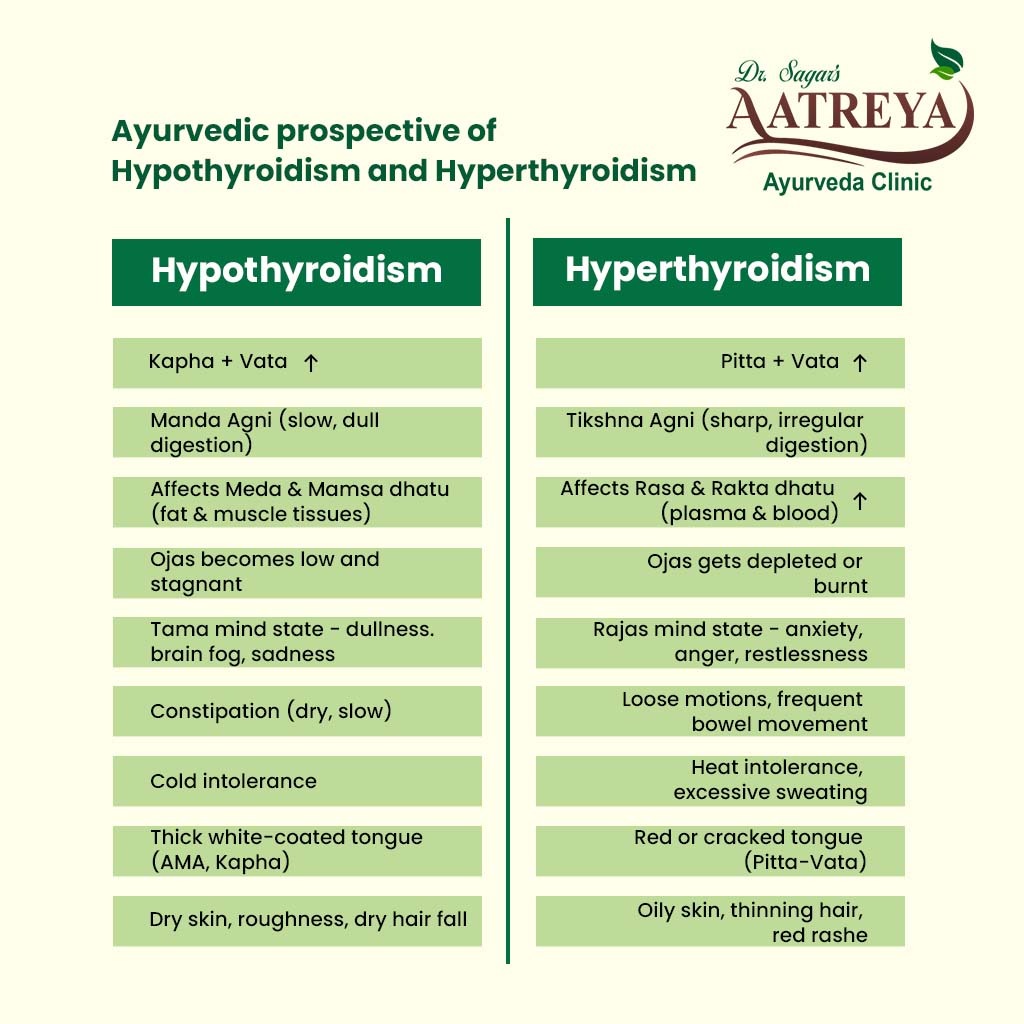Types of Thyroid Disorder :
1. Hypothyroidism
Hypothyroidism is a common health problem. Lack of thyroid hormone or resistance of the body tissue to the thyroid hormone with respect to metabolic demand results in disorder called hypothyroidism. Treatment almost always involves replacing natural hormones with synthetic ones. Life-long use of these drugs can result in many unforeseen health problems.
Varying levels of underactive thyroid are observed in 2-5% of the world’s population. The majority of these are women. The main reason for daily challenges faced by this group is lack of physical and psychological wellbeing.
Modernization and an undue influence of the western culture has had far reaching effects. Drastic changes can be seen in the dietary and lifestyle practices of individuals, which have taken a turn for the first. The consumption of processed food, and a sedentary lifestyle, while in tandem with an increasingly toxic environment, has started to cause various diseases. And hypothyroidism is one of them. Typically, hypothyroidism is defined by imbalance of hormones within the body, but in reality, it is a consequence of inadequate energy available to the body and mind during the day.

Ayurveda, the Indian system of medicine from India already offers a profound and deep understanding of hypothyroidism that also provides an individualized solution to the problem. According to it, hypothyroidism is related to a weak digestive system (Jatharagni) and a diminished metabolic fire (Dhatawagni), an impaired tissue metabolism system and to aggravated doshas, specifically the Kapha and the Vata doshas. It is found that there is an abnormality of Rasavaha srotasa, Raktavaha srotasa, Medovaha srotasa, manovaha srotasa and shukravaha srotasa. In fact, it is usually a combination of all these factors that, when on imbalance, lead to disease. While of course hypothyroidism is not named exactly in the classical Ayurvedic texts, it has been dealt with by mapping and understanding the physiological elements that are involved in it.
What is Hypothyroidism According to Ayurveda :
Dhatvagnimandya is an Ayurvedic concept that is the most closely aligned with the concept of hypothyroidism. According to it, the problem begins at a much deeper level than is described in modern medicine, ie in the tissues. In Ayurveda, initial digestion in the GIT is governed by Saman Vayu, Pachaka Pitta, and Kledak Kapha, which activate Jatharagni, which breaks down complex food into simple molecules for tissue and cell nutrition. This assimilation is managed by Dhatwagni , crucial for healthy Dhatus (body tissues). When Jatharagni (digestive fire) is impaired, it directly impacts Dhatwagni (tissue metabolism) and disrupted Dhatwagni impairs Dhatu function and quantity. Essentially, Ayurveda views all metabolic activities as controlled by Agni. And so, an affected metabolic system is equated with an aggravated Agni. The progression of diseases like hypothyroidism, which are characterized by degeneration of tissues and function, stems from the hypo functioning of Jatharagni, which then negatively impacts Dhatwagni (Dhatwagnimandya) leading to the formation of Ama. This Ama then moves in the body, obstruct the bodies channels and impedes the formation, function and efficiency of the tissues.
Ayurvedic symptoms of Ama, as described by Acharya Vagbhatta, mirror those of hypothyroidism:
- Srotorodha (Channel Obstruction): Leads to stunted growth and hoarseness of voice.
- Balabhransha (Loss of Strength)
- Gaurava (Heaviness): Results in a swollen, puffy face and weight gain.
- Anil Mudhata (Impaired Vata): Presents as a slow heart rate, reduced breathing, joint pain, and poor concentration.
- Aalasya (Lethargy): Manifests as tiredness and sleepiness.
- Apakti (Indigestion): Causes digestive issues.
- Aruchi (Anorexia): Leads to loss of appetite.
- Malsanga (Stool Retention): Results in constipation.
- Klama (Fatigue): This kind of fatique can causes a slower thought process and also feels mild exhaustion.
The Kapha and the Vata doshas, the two kind of doshas are the major part of charge of regulating structures of body’s internal structure. It helps for regulating body;s internal structure, lubrication and multiple types of movements. When they are in an aggravated form, they consequently lead to a host of problems, such as rapid weight gain, swelling, sluggishness and even an intolerance to cold, all of which are classic symptoms of hypothyroidism.
Causes of Hypothyroidism According to Ayurveda :
Ayurveda identifies several causative factors, or Nidanas, that contribute to the onset of Agnimandya and subsequently hypothyroidism
Dietary Habits:
- Drinking too much water. (Atyambupana) -weakens the digestive fire by overhydrating the gastrointestinal system
- Eating at irregular times. (Adhyashana, Vishamashana)- disturb the body's natural rhythm and impair digestion which leads to formation of Aama.
Lifestyle Factors:
- Suppressing natural urges (like urination or defecation)- The suppression of natural bodily urges, or Vega dharana, can also disrupt Vata dosha, leading to metabolic disturbances.
- Disrupted sleep patterns (sleeping during the day, staying up at night)- Less sleep, wrong times of sleep and even disturbed sleep can be huge contributors to hypothyroidism. Referred to as Swapna Viparyaya,, that is sleeping during the day and staying awake at the night, this factor is known to aggravate both the Kapha and the Vata doshas, leading to the effects as mentioned above.
Emotional States:
- Jealousy
- Fear
- Anger
- Confusion
- Pain
- Depression
- Worry
- Grief
These emotional factors can lead to Rasa dhatu dushti or Rasavahasrotasa dushti.
Treatment of Hypothyroidism According to Ayurveda :
Like all Ayurvedic treatments for a plethora of problems, even hypothyroidism has a comprehensive, deep and individualised treatment part that is administered by experienced Ayurvedic practitioners. Instead of just addressing the symptoms like modern medicine does, Ayurveda always weeds out the root cause of a problem. And in case of hypothyroidism this problem’s got courses or a diminished digestive fire, eliminating toxins, imbalance doshas and obstructed bodily channels. The treatment is usually undergone in steps.
Step 1: Deepana or stimulating the digestive fire : This requires the use of specific herbs and their formulations that enhance the effectiveness of the digestive and metabolic systems. Shatapushpa, Pippali, and Sunthi are the herbs that are usually used for the same.
Step 2: Pachana or digestion : In this step, the toxins that are accumulated in the body are metabolised and eliminated without increasing or affecting the digestive fire and ability. Once this is achieved, the next steps of detoxification can ensue.
Step 3: Shodhana, ie purification: A crucial part of the Ayurvedic therapies, this cleanses the body and returns it to its natural state. It has the use of Panchakarma, a pillar of Ayurvedic therapies, that administers procedures like Vamana ie emesis, Virechana ie purgation, Nasya ie elimination through the nasal route, and Basti ie medicated enema. These procedures have multifold benefits which include the expulsion of vitiated doshas and toxins from the body, cleansing and opening of obstructed body channels, rejuvenation of tissues, balance of doshas and an overall physiological betterment. In order to make sure that the effects of the therapy is administered are long-lasting and continually beneficial, the Rasayana therapy is recommended. In this phase of the curative procedure, formulations made of herbs or administered which helps in strengthening and rejuvenating the tissues while also enhancing the immunity of the individual.
In some types of cases, therapies and mainly aimed at mental types of rejuvenation such as Manoharshana. For internal part of the regimen, yoga and light exercise are recommended which helps for maintaining the regulating the overall body structure. This can helps for maintaining peaceful practice of body and provides a perfect breating exercise. Overall, it maintains the good balance between physical, mental and emotional well-being.
And of course a major part of treating hypothyroidism is the patient itself. Consuming a healthy, wholesome and well-rounded diet which includes easily digestible, whole, warm, freshly prepared and light food is a must when it comes to getting out of hypothyroidism. Ayurveda especially recommends the consumption of slightly old rice, barley, green gram and bitter vegetables as a regular practice. And it very seriously advices the avoidance of processed and refined food as well as dairy products.
In addition to this a clean lifestyle is also advised, with habits and changes that one must incorporate in order to lead it in a healthy manner. This means regular exercise, regular sleep, less stress and a disciplined routine.
2. Hyperthyroidism
Hyperthyroidism, or an overactive thyroid, makes more thyroid hormones than the body needs. This might speed up the metabolism too much.
Hyperthyroidism is a clinical illness characterised by a hypermetabolic state that induces agitation, anxiety, tachycardia, hand tremors, profuse perspiration, weight loss, and insomnia.
Ayurveda compares the indications and symptoms of thyroid illnesses to those of many other diseases, such as Galganda, Atyagni, Bhasmaka, and Ati Karshya. When someone has Hyperthyroidism, the symptoms of Pitta Vriddhi, Vata Vriddhi, and Kapha Kshaya are more common. Kapha Kshaya causes Kshaya in other Dhatus and Updhatus.Kapha kshaya causes the kshaya of Rasa, Mamsa, Meda, Majja, and Sukra Dhatus. Artava is a type of Rasa dhatu. It was also discovered to be lower because of Rasa kshaya, which was induced by Kapha kshaya. In this disease, all the Dhatus become weak, and the person becomes cachectic and suffers from the syndromes of Hritpeeda, Hriddrava, Kampa, Shosha, Alpayapicheshtaya Sharma, Sphikgreevodar Sushkata, Krishata, Shrama, Kesha-Nakha Prapatanam, Dourbalya, Asthi Saushirya, Ashaktimaithune, Yathochitkala-darshanam, and Alpa Artavata.
Ayurveda treats hyperthyroidism by balancing the Pitta and Vata doshas and controlling a hyperactive metabolic fire called Atyagni.

Basti treatment (enema) like Tikta ksheera basti , Mustadi yaapan basti, balya basti and brumhan bastis are used in the treatment of hyperthyroidism to bring out Vata Pitta into equilibrium and also helps in nourishing dhatus.
Nasya (putting oil in the nose) and Shirodhara (putting oil on the forehead) are two ways to quiet the nervous system and deal with stress.
Shamana Chikitsa includes Ashwagandha, Brahmi, and Shatavari are some mrdicines which are used that can help with stress, anxiety, and the endocrine system.
Conclusion :
For students, working couples, and homemakers in Tathawade, Pune’s upcoming suburbs, managing thyroid-related issues holistically is no longer a dream. Our clinic, Aatreya Ayurvedic Clinic, Pune’s most known Ayurveda clinic, provides safe, gradual, and effective Ayurvedic treatment for thyroid disorder in Tathawade. Our line of treatment is always designed to match one’s daily rhythm and life stage. If you're interested in going beyond the standard prescription, visit us in Pune for guidance, care, and complete cure of all your thyroid/ hypothyroidism.
FAQs :
-
1. Can Ayurveda completely cure hypothyroidism?Ayurveda doesn't just treat symptoms but targets the cause. Even in early or mild cases, with proper treatment and lifestyle changes, Ayurveda can reduce synthetic hormone dependency to a great extent and possibly reverse the condition.
-
2. How long does Ayurvedic treatment usually take for hypothyroidism?The length of time taken for treatment varies according to the chronicity and gravity of the disorder. Improvement can be seen in 3 to 6 months, but full restoration takes more time. Patience and self-discipline are the watchwords.
-
3. Is Panchakarma essential for treating hypothyroidism?Panchakarma is very useful in chronic and toxin-burdened diseases. Not every patient, however, needs rigorous detox. A good Ayurvedic doctor will determine it on an individual basis.
-
4. What’s the best kind of diet for someone with hypothyroidism?A Kapha-reducing, warm, light, and easy-to-digest diet would be best. Steering clear of dairy, sugar, and heavy meats and emphasizing grains such as barley and old rice, with bitter vegetables, aids in recovery.
-
5. How much does mental health affect hypothyroidism management?Mental health is very significant. Manovaha Srotas involvement reflects the significance of emotional welfare. Mind-calming practices and psychological hardening measures like meditation, yoga, and herbal nootropics are very important in wholistic therapy.

